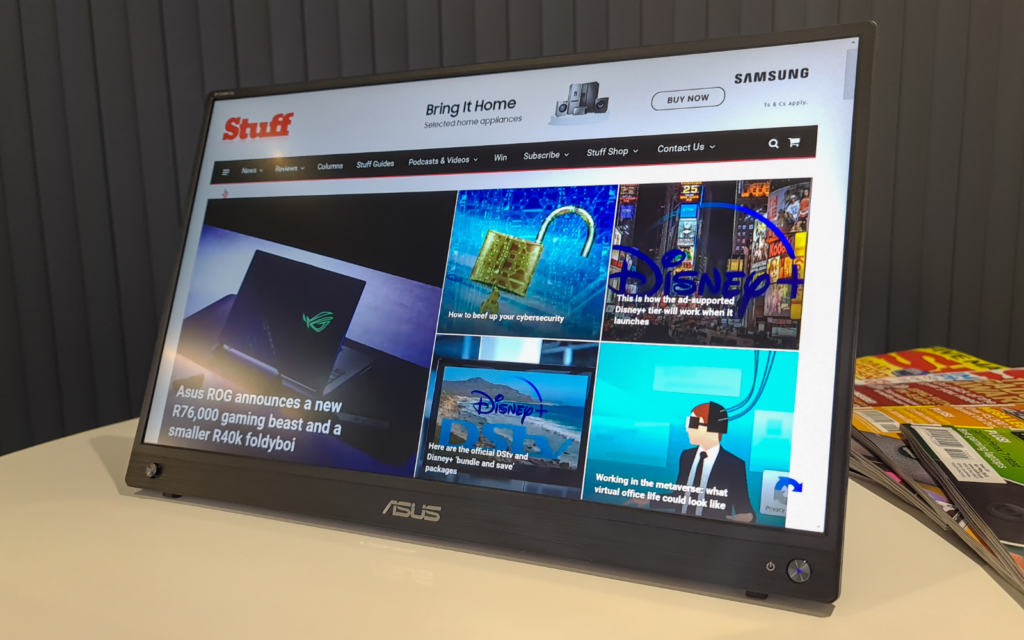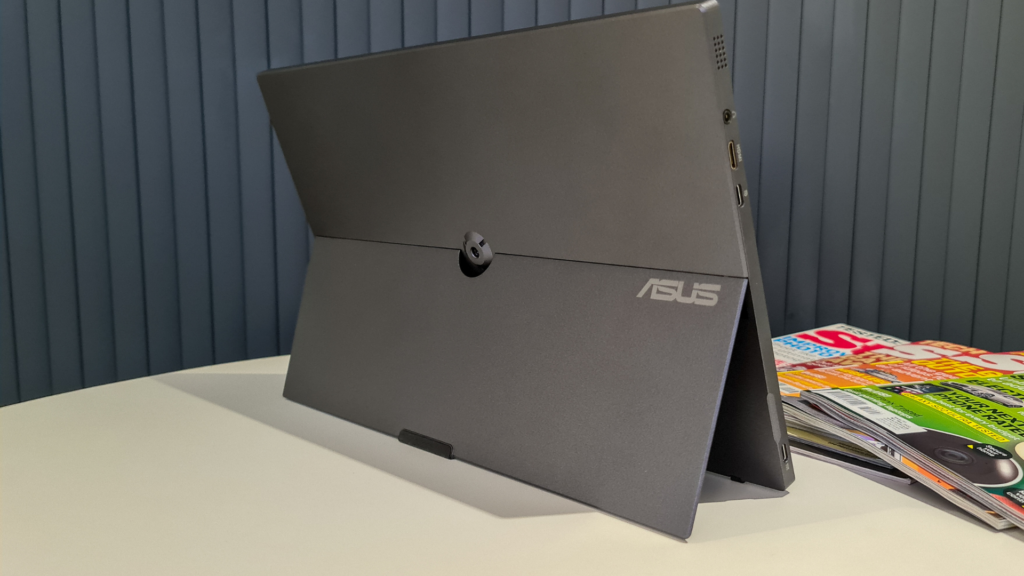If you're always on the go and find your laptop or tablet doesn't offer enough screen space, this is an easy recommendation. The colours, contrast, and viewing angles will really make that PowerPoint pop. But at this price point, we would've expected touch support.
-
Design
-
Display
-
Performance
-
Price
-
Features
There aren’t many players in the portable monitor space. Lenovo, Dell, ViewSonic, and Asus all have something to offer. We’ve spent the last week or two with Asus’ latest, the ZenScreen. Specifically, the ZenScreen Go MB16AWP.
Not to be confused with the ZenScreen Go MB16AHP, ZenScreen MB166C, ZenScreen MB16ACV, ZenScreen MB16AH, ZenScreen MB14AC… you get the idea. We’ve definitely seen a better naming scheme but have we seen a better portable monitor?
Not really. It’s a little difficult to recommend because it’s not exactly cheap and there’s no touchscreen support, but if it’s been a good month and you’re looking for a good quality portable monitor, you should at least consider this one.
They don’t make ’em like they used to
If this review had to boil down to just one word to describe the ZenScreen Go MB16AWP, that word would be ‘clean’. Spanning the overall design, materials used and wireless experience, everything feels tidy.
The bezels that surround the monitor don’t get in the way and help protect the display if it ever finds itself face down. There’s a metal kickstand around back that gives you a little in the way of tilt. If you want to move it around any more you’ll need a suitable stand or tripod. Asus offers support for one with a 1/4in socket but you won’t find one included in the box.
You also won’t find replacement rubber feet included. We’re just nitpicking but if you lose the one on the stand, good luck standing this up on a smooth surface. It’s possible, just not very pleasant. Or safe.
As far as portable monitors go, this size and form factor is very attractive. It’s small and heavy enough (just over 1kg) to not be blown over in a strong breeze, while measuring just 11.5mm thick. Just don’t sit on it. The stand hinges don’t feel very sturdy.
Show us what you got
On to what actually matters: the display. You’re getting a 15.6in IPS LCD panel with a resolution of 1,920x 1,080 and an aspect ratio of 16:9. Pretty standard stuff. It’ll also manage up to a 60Hz refresh rate but that could dip to 30Hz when the juice starts to run thin.
This display performed well above what we were expecting in terms of colour accuracy, brightness, and contrast. Colours stand out without being overly saturated. That’s to be expected from an IPS panel. Unfortunately, together with that comes IPS glow. Luckily for us, it wasn’t as prevalent on the ZenScreen Go MBwhatwhat as we’ve seen on other IPS monitors.
Asus says the contrast is 1200:1. If that’s true, that’s on the higher end for IPS displays. The actual performance is probably less. Not that it really matters though. It should look fine, whether inside an office or outside on a cafe table. Using an IPS panel means you needn’t sit directly in front of it to get the best colours. That’s especially important on a monitor like this that you’re likely to use as a second monitor together with your laptop, tablet or smartphone.
Plug in or unplug
You get the choice of mini HDMI, USB-C, or wireless connectivity options. You’ll even get a mini HDMI to full-size HDMI adapter in the box. All those ports, together with a dedicated USB-C power port are found down the left side. That’s also where you’ll find the 3.5mm headphone jack and one of the two 1W speakers. Yes, speakers are included. They don’t sound amazing, but they’re better than nothing.
But you are not going to want to plug anything in if you can help it. The ZenScreen Go MBlahblah supports casting over WiFi, Miracast, and AirPlay. We don’t think we’ve ever felt as untethered as when we connected it to a laptop and then went wherever we wanted, unencumbered by the stress of looking for plug points.
That weightlessness and portability are thanks to the internal 7,800mAh battery. It’s also why a small 15.6in display weighs over 1kg. That battery will last between three to four hours, depending on your usage and connection type. It’ll last longer if you connect wirelessly and enable Eco Mode (duh) while HDMI and USB-C will drain it quicker. Recharging the ZenScreen Go MByadayada over USB-C with the included 45W charger takes around two and a half hours.
All the extras
There’s also a G-sensor inside, much like the one in your smartphone, that’ll autorotate the display when you flip it into portrait orientation. The stand doesn’t feel as stable in portrait though and you’ll need to download a driver if you’re using a wired connection.
There are a few external extras as well. We mentioned the HDMI adapter. You also get a nifty pouch, a decent USB-C to USB-C cable, and a cover for that stand mounting point. We assume that’s to keep it free from fluff and dirt.
Asus ZenScreen Go MB16AWP verdict
The ZenScreen Go MB16AWP is easy to recommend to people that are constantly on the go or who really hate struggling to find plug points. That is, provided you don’t mind paying through your teeth. The feature-set, while nice to have, doesn’t quite feel worth it. We would’ve liked to see touch support at this price. In this case, you can’t have your screen and touch it, we guess.
The Asus ZenScreen Go MB16AWP will be available in South Africa from July 2022 with an MSRP of R11,500. Keep your eye on Asus’ online store if you want to pick one up.

